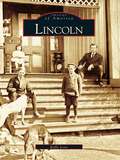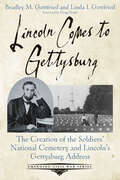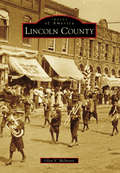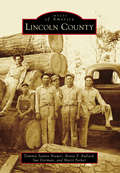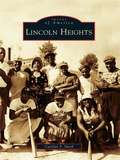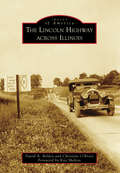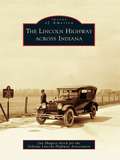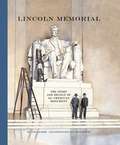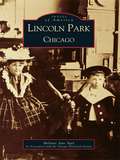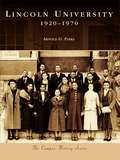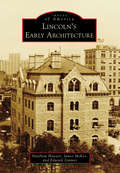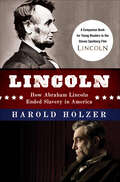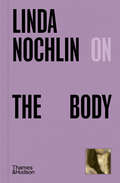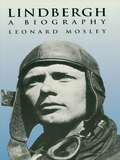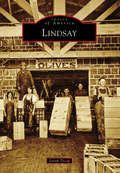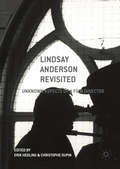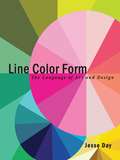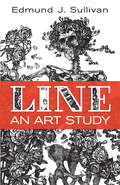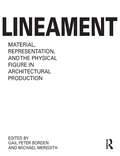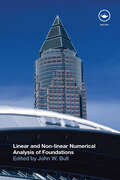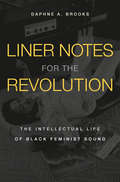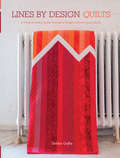- Table View
- List View
Lincoln
by Kelly LoveLocated near the convergence of the Choccolocco Creek, the Blue Eye Creek, and the Coosa River, whose Native American names pay tribute to the Muskogee who once populated the town, Lincoln attracted early settlers after the Cusseta Treaty was signed with the Creek Indians on March 24, 1832. Andrew Jackson passed through Lincoln on his way to the Battle of Horseshoe Bend, when the town was still known as Kingsville and before it was renamed in 1856 for a famous soldier who fought in the War of Independence. Though Lincoln suffered during the Depression-closing its two banks and many businesses-it has recovered to become the eighth-fastest growing city in Alabama.
Lincoln Comes to Gettysburg: The Creation of the Soldiers’ National Cemetery and Lincoln’s Gettysburg Address (Emerging Civil War Series)
by Bradley M. Gottfried Linda I. GottfriedAlmost 8,000 dead dotted the fields of Gettysburg after the guns grew silent. The Confederate dead were hastily buried, but what of the Union dead? Several men hatched the idea of a new cemetery to bury and honor the Union soldiers just south of town. Their task was difficult to say the least. First, appropriate land needed to be identified and purchased. After the State of Pennsylvania purchased the 17 acres, a renowned landscape architect designed the layout of the cemetery. All was now ready for the bodies to be interred from their uneasy resting places around the battlefield, placed in coffins, marked with their names and units, and transported to the new cemetery to be permanently reinterred. More than 3,500 men were moved to the Soldiers National Cemetery. As these tasks gained momentum, so too did planning for the cemetery’s consecration or dedication. A committee of agents from each state who had lost men in battle worked out the logistics. Most of the program was easily decided. It would be composed of odes, singing, prayers, and remarks by the most renowned orator in the nation, Edward Everett. The committee argued over whether President Abraham Lincoln should be invited to the ceremony and, if so, his role in the program. The committee, divided by politics, decided on a middle ground, inviting the President to provide “a few appropriate remarks.” To the surprise of many, Lincoln accepted the invitation, for the most part crafted his remarks in the Executive Mansion, and headed to Gettysburg, arriving on the evening of November 18, 1863. The town was filled with thousands expecting to witness the “event of the century.” Lincoln completed his remarks and, the following day, mounted a horse to join the procession heading for the cemetery. The program was unremarkable, except for Lincoln’s remarks, whose reception was split along party lines. Lincoln Comes to Gettysburg: The Creation of the Soldiers’ National Cemetery and Lincoln’s Gettysburg Address by Bradley M. Gottfried and Linda I. Gottfried recounts the events surrounding the creation of the Soldiers’ National Cemetery, its dedication, and concentrates on Lincoln’s visit to Gettysburg on November 18- 19, 1863.
Lincoln County
by Glen V. McintyreTo the east of Oklahoma City, Lincoln County lies in east central Oklahoma with Chandler as its county seat. The county was opened by two land runs: the first on September 22, 1891, and again four years later on May 23, 1895. The land is primarily rolling grass hills covered with stands of blackjack oak and post oak and is part of what is called the Crosstimbers. Images of America: Lincoln County celebrates the different tribes that lived in the area: the Sac and Fox, the Iowa, and the Kickapoo. It also features famous lawman Bill Tilghman, Olympic athlete Jim Thorpe, poet Jennie Harris Oliver, and governors J.B.A. Robertson and Roy J. Turner. Oil came early to Lincoln County and continues to play a large role in the economy. At one time, the county was covered in cotton fields. It is also a center of transportation with several railroads, old Route 66, and the Turner Turnpike, which today is the major road connecting Oklahoma City and Tulsa.
Lincoln County (Images of America)
by Bettie P. Bullard Marti Parker Sue Dorman Tammie Santos BrewerOn April 7, 1870, an act of the state legislature created Lincoln County, named for Pres. Abraham Lincoln, from Lawrence, Franklin, Copiah, Pike, and Amite Counties. Settlement began more than 50 years earlier with Samuel Jayne's small trading post on St. Stephens Road. Extensive timber resources, the arrival of the railroad in 1857, and the 1859 founding of Whitworth Female College put the county on the map. Logging, lumber mills, and other industries brought scores of people to the region. The agricultural endeavors of cotton and farming provided a way of life before the oil boom of the 1940s. The varied ethnic and religious history of the residents further shaped the county into what exists today.
Lincoln Hall at the University of Illinois
by John HoffmannLincoln Hall at the University of Illinois, named to commemorate the centennial of Abraham Lincoln's birth, has long been a familiar landmark on the Urbana-Champaign campus and the home for undergraduate and graduate work in the liberal arts and communication. Funded by the Illinois State Legislature in 1909, the building was dedicated in 1913 on Lincoln's birthday, February 12. In addition to its function as space for offices, classrooms, and departmental libraries, Lincoln Hall was commissioned, designed, and built to convey "the wisdom and patriotism of the democracy of learning." That spirit of freedom and equality in education was manifest in Lincoln Hall's artistic design, which features terra cotta panels depicting Lincoln's life, quotations from his writings, and portraits of prominent figures of his day. At the outset of the building's conception, Evarts B. Greene, professor of history and dean of the College of Literature and Arts, provided detailed information about Lincoln that defined the building's artistic program. Wishing to retain the dignified simplicity of the overall design, he conferred with W. Carbys Zimmerman, the State Architect, about the nature and placement of the panels and other ornamental details that have become key features of the building's design. Commemorating the bicentennial of Lincoln's birth, this magisterial volume chronicles the history of Lincoln Hall from its conception to its expansion and its present role on the campus. John Hoffmann identifies each of the building's historical panels and the portraits of Lincoln's contemporaries. Lavishly illustrated to show how much care was taken with the details of the design, this book provides a lasting historical record of the building's century-long place at the University of Illinois. Supported by the Office of the Chancellor of the University of Illinois at Urbana-Champaign
Lincoln Heights (Images of America)
by Carolyn F. SmithLocated north of Cincinnati in the Mill Creek Valley, Lincoln Heights was the first African American self-governing community north of the Mason-Dixon Line. The development of Lincoln Heights began in 1923 when the Haley-Livingston Land Company of Chicago sold lots to black families in an unincorporated area called the Cincinnati Industrial Subdivision, now the southern section of Lincoln Heights. Water and sewerage were provided by special assessment through the Works Progress Administration, there were no building and zoning code services, fire and police protection were virtually nonexistent, and street maintenance and lighting were extremely inadequate. In 1939, residents of the area began efforts to incorporate so they could provide safety and necessary services for their growing community. Several of the original petitioners for incorporation lived in the Valley View subdivision, which later became the Wright Aeronautical plant, where many black migrants from the South came to help manufacture the famous B-29 bomber.
Lincoln Highway Across Illinois, The
by David A. Belden Christine R. O’brien Kay SheltonFrom southern Cook County to the Mississippi River, the Lincoln Highway meanders through many of Chicago's suburbs before heading west through Illinois's fertile farmland. America's first transcontinental highway once stretched nearly 3,400 miles from New York City to San Francisco. The story of the highway's role in shaping the contemporary American highway system is one that examines the interaction of technology and human spirit. Conceived by entrepreneur Carl G. Fischer in 1912 and endorsed by businessman Henry B. Joy, the idea of creating an automobile-friendly roadway spanning America would soon change the nature of travel in the 20th century. Lincoln Highway in Illinois defines and describes the role of the highway as it zigzags its way across the "Land of Lincoln" and highlights the cities, towns, and rural communities along its route.
Lincoln Highway across Indiana, The
by Jan Shupert-Arick Indiana Lincoln Highway AssociationThe Lincoln Highway across Indiana explores Indiana's unique role in Lincoln Highway history and celebrates Indiana's place in early automotive and road-building history. Once known as the "Main Street of America," the Lincoln Highway route was established across northern Indiana in 1913, linking larger cities--Fort Wayne, Elkhart, Goshen, South Bend, LaPorte, and Valparaiso--to smaller communities. Most Lincoln Highway towns renamed their main streets Lincolnway in recognition of the nation's first coast-to-coast auto road. When the Lincoln Highway Association shortened the route in 1926, the route linked Fort Wayne to Columbia City, Warsaw, and Plymouth, giving the state two Lincoln Highway routes. From Fort Wayne to the famous Ideal Section, between Dyer and Schererville, Indiana's Lincolnway towns remain proudly connected to Lincoln Highway history. Through vintage photographs, postcards, advertisements, and other historical records, this armchair tour of the highway visits sites favored by early tourists, documents the people and places that made the highway a vital corridor, and celebrates Hoosier Carl Fisher's leadership in the formation of the Lincoln Highway Association, as well as the people who work to preserve its legacy today.
Lincoln Memorial
by Jay Sacher Chad GoweyThough Abraham Lincoln remains one of the most beloved figures in American history and millions of people visit the Lincoln Memorial each year, few are familiar with the intriguing stories behind this national monument. In authoritative yet friendly text and handsome watercolor illustrations, this volume reveals fascinating facts about the monument's design and construction, historic events that took place there, and insights into the role this elegant edifice has played in the creation of a national identity. From 19th-century political infighting to Martin Luther King Jr. and beyond, this is a celebration of an iconic American and a famous memorial-- and the ideal gift for architecture lovers and history buffs.
Lincoln Park, Chicago
by Chicago Historical Society Melanie Ann ApelSince it was founded by German immigrants in the late 1800s, Chicago's Lincoln Park neighborhood has been an exciting and ever-changing place to live. Bordered by Diversey, Ashland, North Avenue, and Lake Michigan, Lincoln Park has undergone countless changes while always remaining a strong Chicago community.Through a collection of more than 200 photographs, Lincoln Park, Chicago offers the reader a journey through homes, schools, businesses, museums, churches, the Lincoln Park Zoo, and the park itself. With anecdotes and images from before the Great Chicago Fire of 1871, to the 1940s when war turned family homes into rooming houses, to the bustling, jam-packed Lincoln Park of today, this vibrant and beautiful neighborhood springs to life.
Lincoln University: 1920-1970 (Campus History)
by Arnold G. ParksLincoln University was founded in 1866 for the education of freed blacks after the Civil War. This book focuses on the years between 1920 and 1970, a span of time during which many of the university'smost signifi cant developments occurred. During this period, Lincoln Institute was elevated to university status, and graduate programs were added to the curriculum. A court-ordered law school was established and graduated many accomplished and respected African American attorneys before disbanding in the 1950s. During this era, the university was often referred to as "the Harvard of the Midwest" due to the acclaimed reputation of its faculty. Many alumni have made outstanding contributions at local, state, and national levels. After the 1954 United States Supreme Court Brown v. Board of Education of Topeka decision, the university integrated its student body. As a result, student enrollment changed dramatically from all black to a signifi cantly white clientele. Today the university retains its designation as a historicallyblack college/university.
Lincoln's Early Architecture (Images of America)
by James Mckee Matthew Hansen Edward ZimmerLincoln's predecessor, Lancaster, formed in 1863 on the east bank of Salt Creek around a proposed Methodist female seminary. Though a building was erected, the school failed to materialize. When Nebraska became the 37th state in 1867, the village of Lancaster was chosen as its first capital, and the name was changed to Lincoln. Although lacking mineral resources, a navigable stream, a railroad, or even a minimal population, the village steadily grew and prospered from its 30 original inhabitants to its present population of more than 260,000. At the time of its origins, critics claimed, "Nobody will ever go to Lincoln who does not go to the legislature, the lunatic asylum, the penitentiary, or some of the state institutions." Images of America: Lincoln's Early Architecture traces the city's growth, including three state capitols and the University of Nebraska, into a modern city of diverse people, events, and businesses.
Lincoln's Springfield Neighborhood
by Richard E. Hart Bonnie E PaullWhen an emotional Abraham Lincoln took leave of his Springfield neighbors, never to return, his moving tribute to the town and its people reflected their profound influence on the newly elected president. His old neighborhood still stands today as a National Historic Site. The story of the life Lincoln and his family built there returns to us through the careful work of authors Bonnie E. Paull and Richard E. Hart. Journey back in time and meet this diverse but harmonious community as it participated in the business of everyday living while gradually playing a larger role on the national stage.
Lincoln: How Abraham Lincoln Ended Slavery in America
by Harold HolzerA new book—and companion to the Steven Spielberg film—tracing how Abraham Lincoln came to view slavery . . . and came to end it.Steven Spielberg focused his movie Lincoln on the sixteenth president's tumultuous final months in office, when he pursued a course of action to end the Civil War, reunite the country, and abolish slavery. Invited by the filmmakers to write a special Lincoln book as a companion to the film, Harold Holzer, the distinguished historian and a consultant on the movie, now gives us a fast-paced, exciting new book on Lincoln's life and times, his evolving beliefs about slavery, and how he maneuvered to end it.The story starts on January 31, 1865—less than three months before Lincoln's assassination—as the president anxiously awaits word on whether Congress will finally vote to pass the Thirteenth Amendment to the Constitution. Although the Emancipation Proclamation two years earlier had authorized the army to liberate slaves in Confederate territory, only a Constitutional amendment passed by Congress and ratified by three-fourths of the states would end slavery legally everywhere in the country.Drawing from letters, speeches, memoirs, and documents by Lincoln and others, Holzer goes on to cover Lincoln's boyhood, his moves from Kentucky to Indiana to Illinois, his work as a lawyer and congressman, his unsuccessful candidacies for the U.S. Senate and his victory in two presidential elections, his arduous duties in the Civil War as commander in chief, his actions as president, and his relationships with his family, political rivals, and associates. Holzer provides a fresh view of America in those turbulent times, as well as fascinating insights into the challenges Lincoln faced as he weighed his personal beliefs against his presidential duties in relation to the slavery issue.The passage of the Thirteenth Amendment would become the crowning achievement of Abraham Lincoln's life and the undisputed testament to his political genius. By viewing his life through this prism, Holzer makes an important passage in American history come alive for readers of all ages.The book also includes thirty historical photographs, a chronology, a historical cast of characters, texts of selected Lincoln writings, a bibliography, and notes.
Linda Nochlin on the Body (Pocket Perspectives #0)
by Linda NochlinRenowned art historian and pioneering feminist Linda Nochlin explores how, from the late eighteenth century, fragmented, mutilated, and fetishized representations of the human body came to constitute a distinctively modern view of the world. Surprising, questioning, challenging, enriching: the Pocket Perspectives series presents timeless works by writers and thinkers who have shaped the conversation across the arts, visual culture, and history. Celebrating the undiminished vitality of their ideas today, these covetable and collectable little books embody the best of Thames & Hudson.
Lindbergh: A Biography (Dover Transportation)
by Leonard MosleyIn this highly readable biography, best-selling author Leonard Mosley offers a fascinating account of Lindbergh's childhood, days as a barnstormer and mail pilot, the flight to Paris and its aftermath, the Hauptmann trial, his later life, and much more. Source Notes. Index. 40 halftone illustrations.
Lindsay (Images of America)
by Sarah TroopA picturesque town nestled among the wildflower-covered foothills of the Sierras, Lindsay is the epitome of the ideal California life--one of health, wealth and sunshine. Lindsay became the heart of the state's second gold rush, when large-scale farming became popular, by hitting the mother lode with oranges. With over 16 citrus packinghouses, people initially came to Lindsay to seek their fortune. The success of the citrus groves attracted not only many skilled Japanese farmers but also many immigrants who were new to the trade. By the 1920s, Lindsay's most famous crop became Lindsay Ripe Olives. Lindsay is a town of surprising inventions and innovations that revolutionized agriculture, citrus farming, irrigation, and especially the olive industry.
Lindsay Anderson Revisited
by Erik Hedling Christophe DupinThis book is about the British film-maker Lindsay Anderson. Anderson was a highly influential personality within British cinema, mostly famous for landmark films like This Sporting Life (1963) and If. . . . (1968). Lindsay Anderson Revisited deals primarily with hitherto unexplored aspects of his career: his biographical background in the British upper class, his devoted film criticism, and his angry relationship to contemporary society in general. Thus, the book contains chapters about his childhood in India, his writings about John Ford, his relationship to French star Serge Reggiani, his work on TV in the 1950s, his troubles with the British film establishment, and his gradually emerging preoccupation with being Scottish, not English. Also featured are chapters written by close friends of Anderson, who died in 1994, dwelling on his penchant for controversy and quarrel, but also on his remarkable artistic talent and commitment.
Line Color Form: The Language of Art and Design
by Jesse DayDesign students today are more visually literate than ever before, and their learning style naturally favors the visual over the textual. So why should they learn art and design theory from a traditional textbook? The only guide of its kind, Line Color Form offers a thorough introduction to design theory and terminology in a visually appealing and accessible format. With hundreds of illustrations and minimal text, this primer was created with visual learners in mind, making it ideal for art students as well as those for whom English is a second language. Each chapter focuses on a single aspect of visual composition, such as line, color, or material. After an illustrated discussion of fundamental vocabulary, the chapters move on to applications of the concepts covered. These applications are again demonstrated through images, including photographs, color wheels, significant works of art, and other visual aids. Each image is accompanied by a descriptive paragraph offering an example of how the vocabulary can be applied in visual analysis. The book culminates with a section on formal analysis, aimed at teaching readers how to express their observations in formal writing and critical discourse. With its emphasis on the visual, this unique guide is a highly effective learning tool, allowing readers to gain an ownership and mastery of terms that will benefit them academically and professionally. Whether you are a design educator, student, or professional, native or non-native English speaker, this bright and concise reference is a must.
Line: An Art Study
by Edmund J. SullivanWritten by a noted illustrator and teacher, this guide introduces the basics of line drawing. British artist Edmund J. Sullivan, who merges the traditional nineteenth-century style of illustration with elements of Art Nouveau, begins by introducing readers to the freehand drawing of abstract lines and advances to the freehand drawing of natural forms, consisting mainly of plane surfaces or single lines.Subsequent chapters illustrate and discuss representations of the third and fourth dimensions, the picture plane, formal perspective, and the drawing of solid objects, including their depiction in shade and shadow, and their modelling. Additional topics include shadows, reflections, and aerial perspective as well as figure drawing.
Lineament: Material, Representation and the Physical Figure in Architectural Production
by Gail Peter Borden and Michael MeredithThis comprehensive catalogue of contemporary work examines the renewed investment in the relationship between representation, materiality, and architecture. It assembles a range of diverse voices across various institutions, practices, generations, and geographies, through specific case studies that collectively present a broader theoretical intention.
Linear and Non-linear Numerical Analysis of Foundations
by John W. BullCorrectly understanding, designing and analyzing the foundations that support structures is fundamental to their safety. This book by a range of academic, design and contracting world experts provides a review of the state-of-the-art techniques for modelling foundations using both linear and non linear numerical analysis. It applies to a range of i
Liner Notes for the Revolution: The Intellectual Life of Black Feminist Sound
by Daphne A. BrooksAn award-winning Black feminist music critic takes us on an epic journey through radical sound from Bessie Smith to Beyoncé. Daphne A. Brooks explores more than a century of music archives to examine the critics, collectors, and listeners who have determined perceptions of Black women on stage and in the recording studio. How is it possible, she asks, that iconic artists such as Aretha Franklin and Beyoncé exist simultaneously at the center and on the fringe of the culture industry? Liner Notes for the Revolution offers a startling new perspective on these acclaimed figures—a perspective informed by the overlooked contributions of other Black women concerned with the work of their musical peers. Zora Neale Hurston appears as a sound archivist and a performer, Lorraine Hansberry as a queer Black feminist critic of modern culture, and Pauline Hopkins as America’s first Black female cultural commentator. Brooks tackles the complicated racial politics of blues music recording, song collecting, and rock and roll criticism. She makes lyrical forays into the blues pioneers Bessie Smith and Mamie Smith, as well as fans who became critics, like the record-label entrepreneur and writer Rosetta Reitz. In the twenty-first century, pop superstar Janelle Monae’s liner notes are recognized for their innovations, while celebrated singers Cécile McLorin Salvant, Rhiannon Giddens, and Valerie June take their place as cultural historians. With an innovative perspective on the story of Black women in popular music—and who should rightly tell it—Liner Notes for the Revolution pioneers a long overdue recognition and celebration of Black women musicians as radical intellectuals.
Lines by Design Quilts: 17 Projects Featuring the Innovative Designs of Esch House Quilts
by Debbie GrifkaDiscover the beauty of a simple line!A line is any shape distilled to its most basic form--but it has unlimited potential! From bold, straight lines to lush curves and lines that draw pictures, Lines By Design will show you how to get the maximum effect out of minimum composition.Using bias applique, machine applique and traditional piecing techniques, author Debbie Grifka offers designs for bold, modern pieces for your home. Featuring twelve bed-sized quilts plus pillows, placemats, table runners and more, you'll be able to choose from something pictorial, such as Community Isolation, featuring outlines of houses and trees, or try your hand at an updated classic, such as Forever, a riff on the classic Double Wedding Ring design.No matter which design you choose, you're sure to fall in love with the simple elegance of lines.
Lines of Vision: Irish Writers on Art
by Janet McleanMarking the 150th anniversary of the National Gallery of Ireland, celebrated Irish writers find inspiration in its magnificent collection In 1864 the National Gallery of Ireland opened to the public in Dublin. It then housed just 112 paintings. Today the gallery holds over 15,000 works of European art and is notable both for its extensive collection of Irish art and its Italian baroque and Dutch masters paintings. For this anthology, published to mark the 150th anniversary of the National Gallery of Ireland, fifty-six Irish writers have contributed short stories, essays, and poems inspired by pictures in the collection. These literary responses to art are by turns profound, playful, and insightful. Authors include acclaimed figures in contemporary Irish literature, such as Colm Tóibín, John Banville, John Boyne, Roddy Doyle, Colum McCann, Paula Meehan, Paul Muldoon, John Montague, and Seamus Heaney. The pictures that the writers have selected are intriguingly diverse. They range from old master paintings by Caravaggio, Rembrandt, El Greco, and Velázquez to works by Impressionist and Post-Impressionist artists such as Claude Monet and Pierre Bonnard, as well as works by Irish artists such as Jack B. Yeats, John Lavery, Gerard Dillon, and Paul Henry. The book is organized alphabetically by writer and each text is illustrated with the chosen work in color. Edited with preface by Janet McLean, Curator of European Art 1850-1950 at the NGI.
